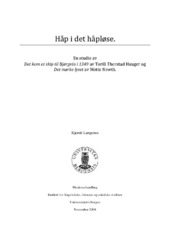| dc.description.abstract | Can it be said that there is hope? In my thesis, I read two novels: Det kom et skip til Bjørgvin i 1349 (1981) by Torill Thorstad Hauger and Det mørke lyset (1995) by Mette Newth. Both of these novels tell sad and tragic stories, but my focus is to find messages of hope. By using J.A. Appleyard's theory about how we become readers, presented in Becoming a Reader. The Experience of Fiction from Childhood to Adulthood (1990), I place Det kom et skip... into a stage he calls "The reader as hero and heroine" and Det mørke lyset into "The Reader as a Thinker" (Appleyard 1990: 14). There are some differences between these two novels. Appleyard describes common features in novels ment for readers in different stages, and I use the description to find different approaches on how hope can be projected into the books. In addition I refer to Wolfgang Iser's theory about open gaps, which he present in "Tekstens apellstruktur" (Iser 1981) and The implied reader. Patterns of communication in prose fiction from Bunyan to Beckett (Iser 1974) , and I find that hope can be recognized in the open gaps of a story. There are differences between the books regarding the amount of- and what type of gaps we are talking about. I ask whether or not it is possible for the reader to experience catharsis. This is the word Aristoteles uses in his definition of tragedy (Børtnes 1980: 31). In order to experience catharsis, the reader needs to identify him-/herself with the main character in the story. I try to find an explanation of the word identification. Hans Robert Jauss explains different types of identification in "Levels of identification of hero and audience" (Jauss 1974). I ask what kind of identification the reader can be said to experience when reading the novels. Both texts deal with death in some way. I ask how death has been, and is, explained to children, and also in what way death is presented in the two novels. In Hauger's novel, I find more of a happy ending than in Newth's. Apparently, the story in which the protagonist is destined to die, is the one that to the greatest extent gives the reader the opportunity to experience catharsis. When reading Det mørke lyset, one is urged to think about life, death, believes; in short the big questions in life. Ernst Bloch has said that "there is (...) rescue - in the horizon (1986: 112). There is hope. | en_US |
